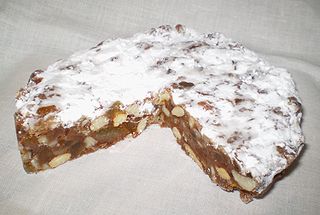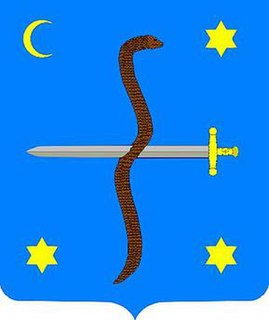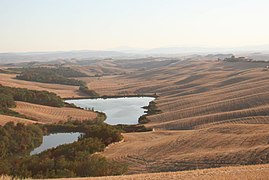
A Chianti wine is any wine produced in the Chianti region of central Tuscany. It was historically associated with a squat bottle enclosed in a straw basket, called a fiasco. However, the fiasco is only used by a few makers of the wine as most Chianti is now bottled in more standard shaped wine bottles. Baron Bettino Ricasoli created the Chianti recipe of 70% Sangiovese, 15% Canaiolo and 15% Malvasia bianca in the middle of the 19th century.

Montalcino is a hill town and comune in the province of Siena, Tuscany, central Italy.

Badlands are a type of dry terrain where softer sedimentary rocks and clay-rich soils have been extensively eroded by wind and water. They are characterized by steep slopes, minimal vegetation, lack of a substantial regolith, and high drainage density. They can resemble malpaís, a terrain of volcanic rock. Canyons, ravines, gullies, buttes, mesas, hoodoos and other such geologic forms are common in badlands. They are often difficult to navigate by foot. Badlands often have a spectacular color display that alternates from dark black/blue coal stria to bright clays to red scoria.

The Province of Siena is a province in the Tuscany region of Italy. Its capital is the city of Siena.

Panforte is a traditional chewy Italian dessert containing fruits and nuts. It is similar to a florentine but much thicker, or a little like a lebkuchen. Known throughout all Italy, it is associated most especially with the Province of Siena.

Asciano is a comune and hill town in the province of Siena in the Italian region Tuscany. It is located at the centre of the Crete senesi between the river Ombrone and the torrent Copra, some 30 kilometres (19 mi) southeast of the town of Siena by rail.

Buonconvento is a comune (municipality) in the Province of Siena in the Italian region Tuscany, located about 70 kilometres (43 mi) south of Florence and about 25 kilometres (16 mi) southeast of Siena in the area known as the Crete Senesi.

Castelnuovo Berardenga is a comune (municipality) in the province of Siena in the Italian region Tuscany, located about 50 kilometres (31 mi) southeast of Florence and about 14 kilometres (9 mi) east of Siena. Since 1932 it is included in the Chianti wine-production area.

Monteroni d'Arbia is a comune (municipality) in the Province of Siena in the Italian region Tuscany, located about 60 kilometres (37 mi) south of Florence and about 13 kilometres (8 mi) southeast of Siena in the area known as the Crete Senesi. It takes its names from the Arbia torrent, a tributary of the Ombrone River.

Murlo is a comune (municipality) in the Province of Siena in the Italian region Tuscany, located about 70 kilometres (43 mi) south of Florence and about 20 kilometres (12 mi) south of Siena.

Rapolano Terme is a comune (municipality) in the Province of Siena in the Italian region Tuscany, located about 60 kilometres (37 mi) southeast of Florence and about 20 kilometres (12 mi) east of Siena in the area known as the Crete Senesi.

The Val d'Orcia or Valdorcia is a region of Tuscany, central Italy, which extends from the hills south of Siena to Monte Amiata. Its gentle, cultivated hills are occasionally broken by gullies and by picturesque towns and villages such as Pienza, Radicofani and Montalcino. Its landscape has been depicted in works of art from Renaissance painting to modern photography.

Amos Cassiòli was an Italian painter, of battle scenes, historical canvases and portraits. He worked in a Purismo style.

Tuscan wine is Italian wine from the Tuscany region. Located in central Italy along the Tyrrhenian coast, Tuscany is home to some of the world's most notable wine regions. Chianti, Brunello di Montalcino and Vino Nobile di Montepulciano are primarily made with Sangiovese grape whereas the Vernaccia grape is the basis of the white Vernaccia di San Gimignano. Tuscany is also known for the dessert wine Vin Santo, made from a variety of the region's grapes. Tuscany has forty-one Denominazioni di origine controllata (DOC) and eleven Denominazioni di Origine Controllata e Garantita (DOCG). In the 1970s a new class of wines known in the trade as "Super Tuscans" emerged. These wines were made outside DOC/DOCG regulations but were considered of high quality and commanded high prices. Many of these wines became cult wines. In the reformation of the Italian classification system many of the original Super Tuscans now qualify as DOC or DOCG wines but some producers still prefer the declassified rankings or to use the Indicazione Geografica Tipica (IGT) classification of Toscana. Tuscany has six sub-categories of IGT wines today.

The Vegni are an Italian family from Siena. The medioeval origins of the family have limited documentation. The origin of the family is in Siena, with Bencivenne, father of Aringhieri, whose children Guido,Iacobina and Ranieri are mentioned in a contract of a house sale in 1201. The son of Guido, Bencivenni, is the first one to have a recognised profession mentioned in the documents. A notary of the royal chamber, called Bencivennis olim Guidi, was active in Siena in the first part of the 13th century. The patronymic Bencivennis is used, abbreviated as bcVennis in the documents signed by Luca, a notary, in documents he drew up during late 13th. Pietro olim (of) Luca bcVennis was active in Siena until 1321. The sons of Pietro settled in the area of Chianciano, focusing the centre of interests of the family in the South of the Siena Republic until the fall of it in 1555. The surname Bencivennis remains in official documents during all the Republican period, to disappear at the end of the 16th century, substituted by Vegni. The last one to use it in official documents is Eustachio Bencivennis or bcVegnis, again a notary, who died in 1585. His grandson Giovanni Battista di Pietro, a notary in Chianciano between 1600 and 1641, signs his documents as Vegni, although he still uses the same private legal seal with the family coat of arms.

Accona desert refers to a hilly area in the Siena province of Italy, within the municipality of Asciano [43°14'4.30"N; 11°33'37.48"E] often enlarged to include the biancana site of Le Fiorentine - Leonina [ 43°17'32.95”N; 11°26'54.07"E]. The term desert is inappropriate from a physical and climatic point of view, rather the climate is Mediterranean with a hot dry summer and almost 800 mm/y of rain. A real desert has never existed here, unless “desert” was a way of describing severely eroded areas, more properly called “badlands”, even if temporary ones.

The Abbey of Monte Oliveto Maggiore is a large Benedictine monastery in the Italian region of Tuscany, 10 km south of Asciano. Its buildings, which are mostly of red brick, are conspicuous against the grey clayey and sandy soil—the Crete senesi which give this area of Tuscany its name.

Montalcino Cathedral is a Roman Catholic cathedral in Montalcino in the province of Siena, Italy. Formerly the seat of the bishops of Montalcino, since 1986 it has been a co-cathedral in the Archdiocese of Siena-Colle di Val d'Elsa-Montalcino. It is dedicated to the Holy Saviour.
Antonio Ridolfi was an Italian painter, depicting sacred and historical subjects, as well as costume genre pieces.

The Museo d'Arte Sacra della Val d'Arbia is a small museum of religious art in Buonconvento, in the Val d'Arbia to the south of Siena, in Tuscany in central Italy. It contain a number of paintings by important artists of the Sienese School, among them Duccio di Buoninsegna, Sano di Pietro and Pietro Lorenzetti. The museum is housed in the Palazzo Ricci Socini, close to the parish church of Santi Pietro e Paolo.



























